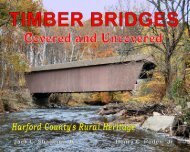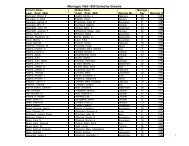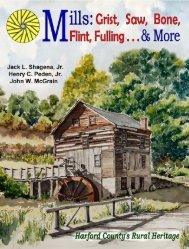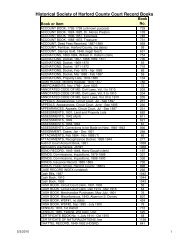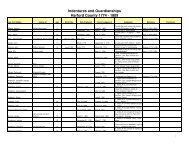Untitled - THE HISTORICAL SOCIETY OF HARFORD COUNTY ...
Untitled - THE HISTORICAL SOCIETY OF HARFORD COUNTY ...
Untitled - THE HISTORICAL SOCIETY OF HARFORD COUNTY ...
Create successful ePaper yourself
Turn your PDF publications into a flip-book with our unique Google optimized e-Paper software.
Preface<br />
It was principally water that powered the development of<br />
industry in early America. Harford County, with its eastern portion<br />
adjacent to the coastal plain and the terrain rising towards the West,<br />
was a geographically ideal location. The fall of water along the Bush<br />
River, Winters Run, Bynum Run, Little Gunpowder Falls, and Deer<br />
Creek provided about one hundred locations for entrepreneurs to<br />
build and operate mills.<br />
Josiah Carter was the first to acquire a waterpower site in the<br />
northwestern part of the county along Deer Creek called “The<br />
Miller’s Fancy.” In 1792, he transferred his land and water rights to<br />
Isaac Stansbury whose brother Elijah built a milldam, constructed a<br />
gristmill and sawmill, and established a farm. Although the Stansbury<br />
family had deep roots in Baltimore County going back to 1658, Elijah<br />
was the first to enter the milling business, which was continued by his<br />
descendents for eighty-five years. His legacy remains in the beautiful<br />
brick mansion that still towers over the site.<br />
Stone grist milling introduced by Elijah became obsolete in<br />
the late nineteenth century, and with a change in technology, new<br />
owners emerged to carry on the milling business. In the decades<br />
following the Civil War, however, flour prices fell and with their<br />
decline so did the profits, as a series of entrepreneurs struggled<br />
financially to keep the mill operating.<br />
Help came in 1919 when electrical generators went online to<br />
power lights and machinery in nearby Fawn Grove, Pennsylvania.<br />
This, unfortunately, was short lived, as less than a decade later<br />
maturing of the power industry eliminated the need for the<br />
hydroelectric source. Sustaining its traditional roots, the mill<br />
continued to grind grain for the local community until1964.<br />
In 1965 Harford County Department of Parks and Recreation<br />
acquired the mill and fifty-seven and one-half acres of land. Through<br />
the committed and dedicated support of a volunteer-led non-profit<br />
organization, the park has been revitalized, and today serves<br />
thousands of nature-seeking visitors each year. The group has<br />
recently begun promoting the Historic Eden Mill Museum to attract<br />
people wanting to learn about industrial grain-milling history.




